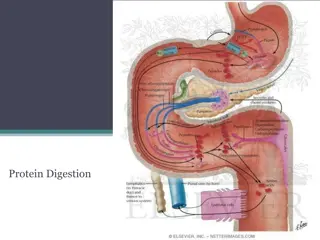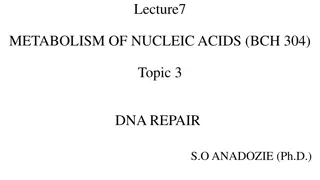Understanding DNA Mutations and Their Types
DNA mutations are changes in the DNA molecule that can lead to permanent alterations in the base sequence of daughter DNA. Causes include uncorrected errors, as well as damage from oxidative deamination, radiation, and chemicals. The types of mutations include point mutations, insertion mutations, d
4 views • 7 slides
Amino Acid Catabolism: Pathways and Reactions
Amino acid catabolism involves removing amino groups via deamination, leading to urea synthesis and TCA cycle intermediates. The process includes transamination and oxidative deamination reactions, with specific aminotransferases catalyzing these reactions. Transamination is a key step in funneling
0 views • 23 slides
Understanding the Urea Cycle in Biochemistry
Explore the intricate process of the urea cycle, its role in removing amino groups from amino acids, converting ammonia into urea in the liver, and managing hyperammonemia. Learn about transamination, oxidative deamination, and the importance of glutamine and alanine in ammonia transport. Discover t
1 views • 26 slides
Understanding the Integration of Carbohydrate, Lipid, and Protein Metabolism
The integration of metabolism involving carbohydrates, lipids, and proteins can be divided into three stages: hydrolysis to simpler units, preparatory stage, and oxidative stage. In the hydrolysis stage, complex polysaccharides, lipids, and proteins are broken down to simpler forms. The preparatory
3 views • 13 slides
Understanding Protein Digestion and Amino Acid Metabolism
The process of protein digestion involves proteolytic enzymes produced by the stomach, pancreas, and small intestine. Pepsinogen is activated to pepsin in the stomach, breaking down proteins into oligopeptides and amino acids. After absorption, amino acids are utilized for protein synthesis and as d
0 views • 7 slides
Urea Cycle: An Overview of Ammonia Detoxification and Urea Formation
Understand the intricate process of ammonia detoxification through the urea cycle, where amino groups from amino acids are converted to urea for disposal. Learn about the importance of transamination reactions, blood transport of ammonia to the liver, and causes and management of hyperammonemia. Exp
0 views • 26 slides
Amino Acid Metabolism Pathways: Transamination, Deamination, and Clinical Significance of Transaminases
Amino acid metabolism involves pathways such as transamination, deamination, and the clinical significance of serum transaminases like ALT and AST. Transamination involves the transfer of amino groups, while deamination involves the removal of the amino group. Transaminases are important intracellul
0 views • 23 slides
Understanding Transamination and Deamination in Biochemistry
Transamination is a vital chemical reaction in biochemistry that transfers amino groups to ketoacids to form new amino acids, playing a crucial role in amino acid metabolism. Enzymes called transaminases facilitate this process, utilizing -ketoglutarate as a key amino group acceptor. The mechanism i
5 views • 17 slides
Understanding Nutrient Absorption in the Digestive System
This content provides a quiz format to test knowledge on the transport of nutrients in blood, digestive processes, and functions of organs such as the liver and gallbladder. Topics covered include nutrient absorption in the small intestine, enzyme production, emulsification of fats, and more. It als
0 views • 50 slides
DNA Damage and Repair: Importance and Consequences
DNA is crucial for genetic information storage, but it can suffer damage from various sources such as UV radiation and tobacco smoking, leading to mutations and diseases like cancer. Understanding the types of DNA damage, including spontaneous deamination and depurination, helps grasp the significan
0 views • 22 slides









